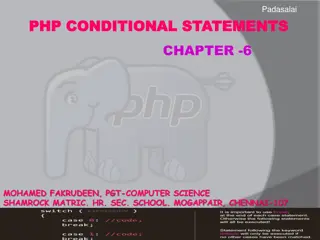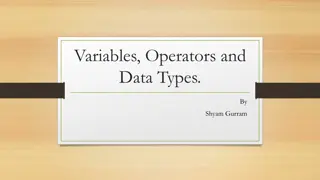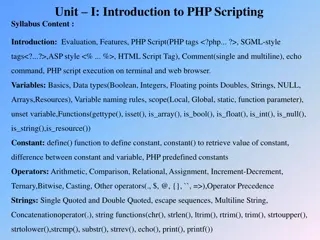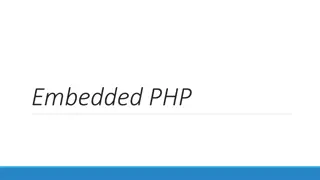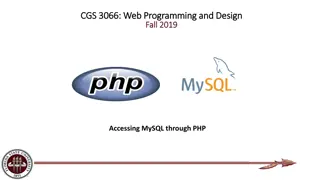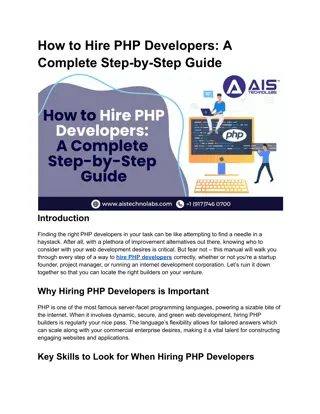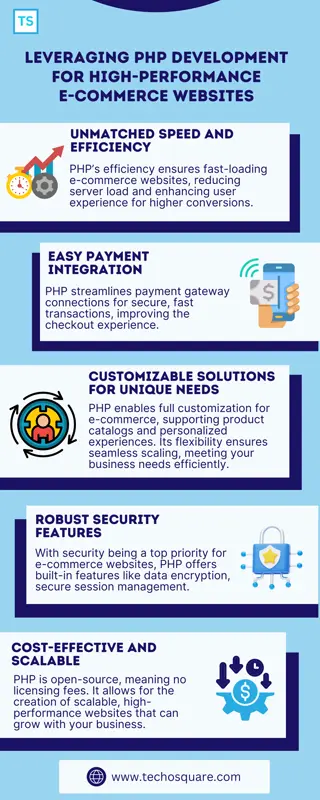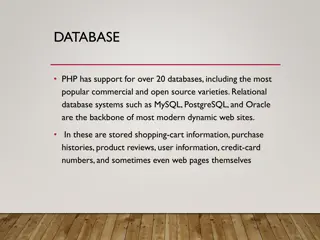
Introduction to PHP - Server-Side Scripting Language Basics
"Learn the fundamentals of PHP with this comprehensive guide covering its features, syntax, and what you can do with PHP. Explore how PHP can generate dynamic content, interact with databases, and handle user access control efficiently."
Download Presentation

Please find below an Image/Link to download the presentation.
The content on the website is provided AS IS for your information and personal use only. It may not be sold, licensed, or shared on other websites without obtaining consent from the author. If you encounter any issues during the download, it is possible that the publisher has removed the file from their server.
You are allowed to download the files provided on this website for personal or commercial use, subject to the condition that they are used lawfully. All files are the property of their respective owners.
The content on the website is provided AS IS for your information and personal use only. It may not be sold, licensed, or shared on other websites without obtaining consent from the author.
E N D
Presentation Transcript
PHP By Prof. B.A.Khivsara Note: The material to prepare this presentation has been taken from internet and are generated only for students reference and not for commercial use.
Introduction to PHP PHP is an acronym for "PHP: Hypertext Preprocessor" PHP is a widely-used, open source scripting language PHP scripts are executed on the server PHP is free to download and use What is a PHP File? PHP files can contain text, HTML, CSS, JavaScript, and PHP code PHP code are executed on the server, and the result is returned to the browser as plain HTML PHP files have extension ".php"
Introduction to PHP What Can PHP Do? PHP can generate dynamic page content PHP can create, open, read, write, delete, and close files on the server PHP can collect form data PHP can send and receive cookies PHP can add, delete, modify data in your database PHP can be used to control user-access PHP can encrypt data With PHP you are not limited to output HTML. You can output images, PDF files, and even Flash movies. You can also output any text, such as XHTML and XML.
Featuresof PHP PHP runs on various platforms (Windows, Linux, Unix, Mac OS X, etc.) PHP is compatible with almost all servers used today (Apache, IIS, etc.) PHP supports a wide range of databases PHP is free. Download it from the official PHP resource: www.php.net PHP is easy to learn and runs efficiently on the server side
PHP Syntax Basic PHP Syntax A PHP script can be placed anywhere in the document. A PHP script starts with <?php and ends with ?>: <?php // PHP code goes here ?> The default file extension for PHP files is ".php".
sample code Example 1 to print Hello World using PHP <!DOCTYPE html> <html> <body> <h1>My first PHP page</h1> <?php echo "Hello World!"; ?> </body> </html>
sample code Example 2 variable declaration <html> <body> Out Put <?php $txt = "Hello world!"; $x = 5; $y = 10.5; "Hello world!" 5 10.5 echo $txt; echo "<br>"; echo $x; echo "<br>"; echo $y; ?> </body> </html>
sample code Example 3- To output text and a variable <html> <body> <html> <body> <?php $txt = "W3Schools.com"; echo "I love " . $txt . ; ?> <?php $txt = "W3Schools.com"; echo "I love $txt"; ?> </body> </html> </body> </html>
Program for addition of two numbers <body> <?php $n1=5; $n2=6; $sum=$n1+$n2; Echo Summation is .$sum; ?> </body>
PHP Comparison Operators Operator Name Example Result == Equal $x == $y Returns true if $x is equal to $y Returns true if $x is equal to $y, and they are of the same type === Identical $x === $y != <> Not equal $x != $y Returns true if $x is not equal to $y Greater than > $x > $y Returns true if $x is greater than $y < Less than $x < $y Returns true if $x is less than $y Greater than or equal to Returns true if $x is greater than or equal to $y >= $x >= $y Less than or equal to <= $x <= $y Returns true if $x is less than or equal to $y
Form Handling- using Post Method a.html Welcome.php <html> <body> <html> <body> <form action="welcome.php" method="post"> Name: <input type="text" name="name"> <br> <input type="submit"> </form> Welcome <?php echo $_POST["name"]; ?> </body> </html> </body> </html>
Form Handling- using Get Method a.html Welcome.php <html> <body> <html> <body> <form action="welcome.php" method= get"> Name: <input type="text" name="name"> <br> <input type="submit"> </form> Welcome <?php echo $_GET["name"]; ?> </body> </html> </body> </html>
Form Handling- Difference between get and post method $_GET is an array of variables passed to the current script via the URL parameters. $_POST is an array of variables passed to the current script via the HTTP POST method. When to use GET? Information sent from a form with the GET method is visible to everyone. GET also has limits on the amount of information to send. The limitation is about 2000 characters. When to use POST? Information sent from a form with the POST method is invisible to others and has no limits on the amount of information to send. However, because the variables are not displayed in the URL, it is not possible to bookmark the page.
How to run Program XAMPP (It contains MySQL , Apache and PHP) Start XAMPP control panel from window s start menu and start Apache and MySQL Required Software To create database and table Goto browser and type localhost/phpmyadmin To write PHP code Use Notepad and give .php extension Save the .php file in XAMPP->htdocs folder->Any folder created by you-> save file with index.php Where to Save .php file go to web browser and write localhost/name_of_folder To run PHP program
Database handling using PHP Connection to MySQL <?php // Create connection $conn = new mysqli( localhost , root , ); //MySQLi extension (the "i" stands for improved) // Check connection if(!$conn){ die('Could not connect: '.mysqli_connect_error()); } echo 'Connected successfully<br/>'; ?>
Select Data From a MySQL Database <?php $conn = mysqli_connect( localhost , root , root , db1 ); if(!$conn){ die(mysqli_connect_error()); } echo 'Connected successfully<br>'; $sql = 'SELECT * FROM STUD'; $rs=mysqli_query($conn, $sql); $nrows= mysqli_num_rows($rs);
Select Data From a MySQL Database if($nrows > 0){ while($row = mysqli_fetch_assoc($rs)){ echo "ID :{$row['id']} <br>"; echo "FNAME : {$row['firstname']} <br>"; echo "LNAME : {$row['lastname']} <br>"; echo "--------------------------------<br>"; } } else { echo No result"; } mysqli_close($conn); ?>
References https://www.w3schools.com/php/php_intro.asp https://www.w3schools.com/php/php_forms.asp https://www.w3schools.com/php/php_mysql_intro.asp



